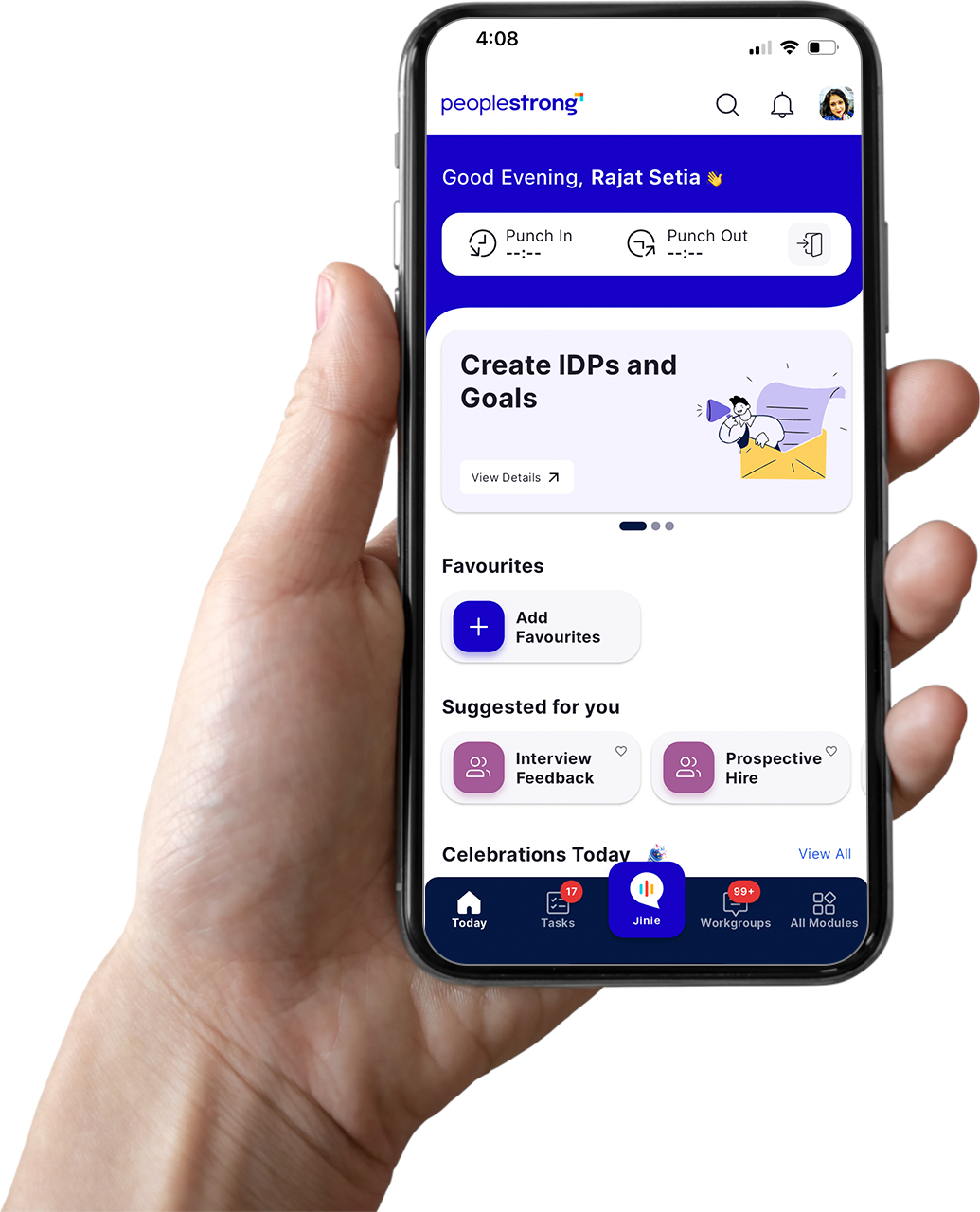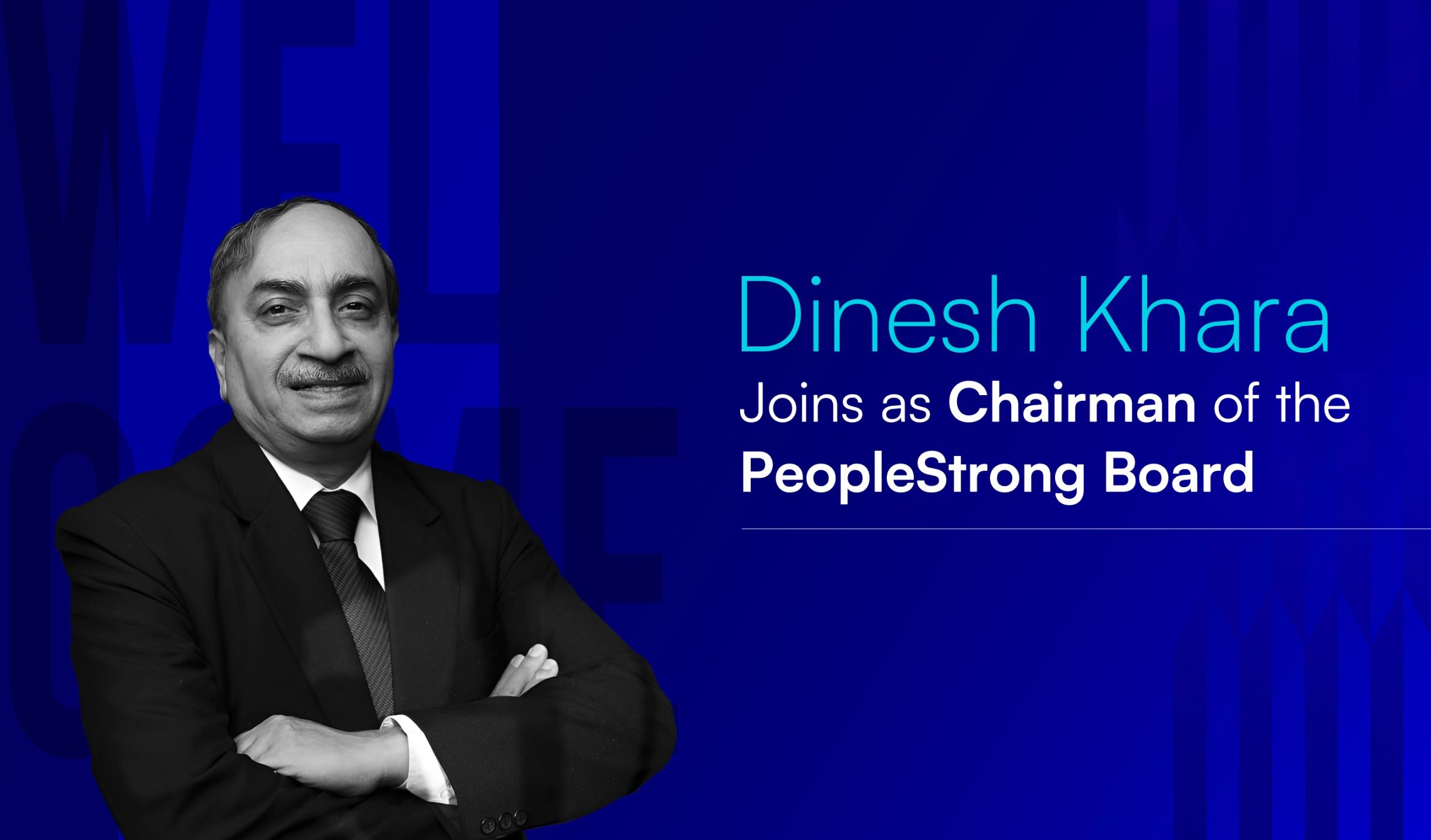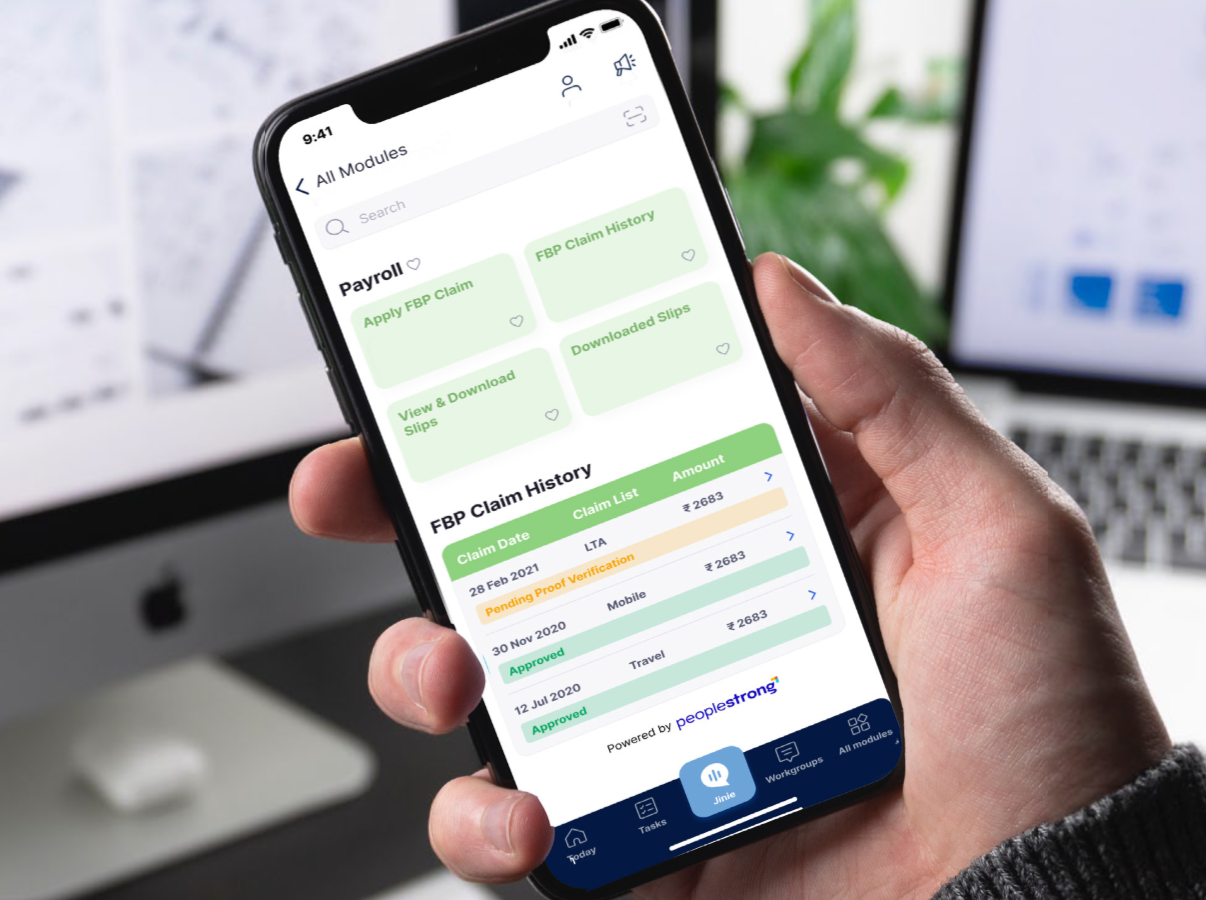Human Resource Planning (HRP) is a strategic process that ensures organizations have the right people in the right roles at the right times. It’s essential for maintaining competitiveness, adapting to change, and achieving long-term business goals.
Effective HRP helps companies forecast their workforce needs, manage talent efficiently, and align HR strategies with overall business objectives.
According to a study by the Work Institute, 78% of the reasons for voluntary turnover could have been prevented by the employer if identified and addressed on time. This underscores that proactive HR planning is important in retaining valuable talent.
Furthermore, organizations that actively engage in HRP exhibit superior performance compared to those that do not, as highlighted by Ogunrinde in 2001. In today’s fast-paced business environment, companies must be agile and ready to respond to market demands swiftly. HRP plays a crucial role in enabling this agility.
HRP isn’t just about hiring and firing; it’s about strategically planning for the future.
For instance, Human Resource Planning (HRP) can help a company like an e-commerce business forecast IT capacity needs based on seasonal trends, ensuring the right infrastructure and support team are in place. Similarly, a design agency might use HRP to anticipate a higher demand for digital media and develop strategies to upskill and reskill its workforce accordingly.
In this blog, we will explore the essentials of Human Resource Planning (HRP), its importance, common challenges, and the steps involved in the HRP process. We’ll also highlight how technology can enhance HRP and provide real-life examples and statistics to bring these concepts to life.
Let’s dive into understanding what Human Resource Planning truly means.
Understanding Human Resource Planning
Human Resource Planning (HRP) is a systematic approach to forecasting an organization’s future HR needs and determining how to meet those needs effectively. It ensures that a company has the right number of employees, with the right skills, in the right places. This process is not just about filling positions but about aligning the workforce with the company’s strategic goals.
HRP involves several key activities:
- Analyzing the current workforce: Assessing the existing employees’ skills, performance, and potential.
- Forecasting future workforce needs: Predicting the types and numbers of employees required in the future.
- Identifying gaps: Determining the difference between the current workforce and future needs.
- Developing strategies: Creating plans to bridge the gaps, which may include hiring, training, or redeploying staff.
A well-executed HRP process helps businesses avoid the pitfalls of under- or over-staffing, reduces costs associated with turnover, and enhances overall productivity.
For example, a law firm might use HRP to plan for future retirements by developing internal leadership candidates and recruiting external talent to ensure a smooth transition.
Importance of HR Planning
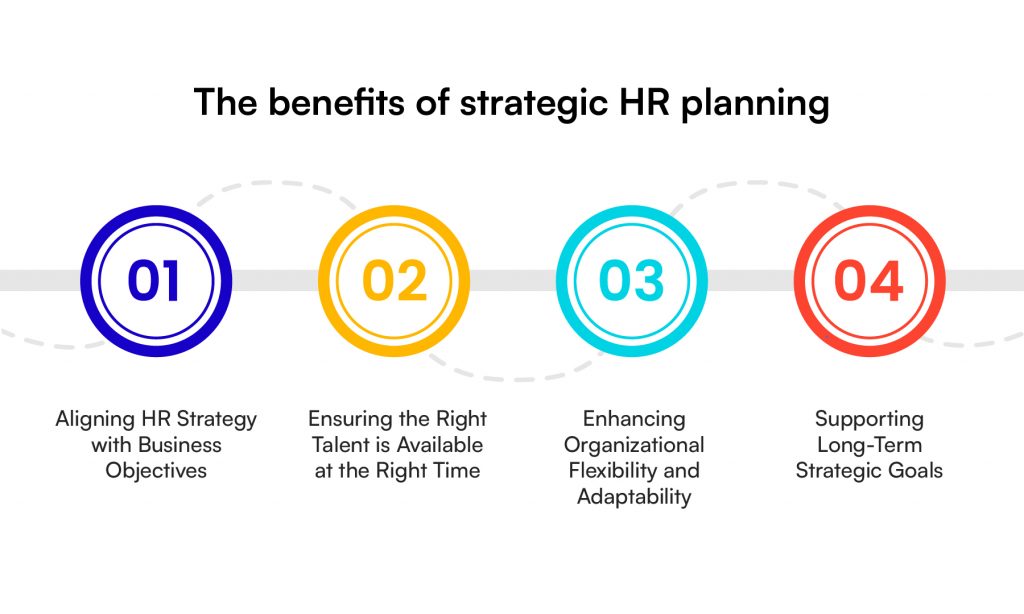
Human Resource Planning (HRP) is critical for several reasons that directly impact an organization’s success and sustainability. Here are the benefits of hr planning:
1. Aligning HR Strategy with Business Objectives
HRP ensures that the human resource strategy is tightly aligned with the overall business strategy. Understanding long-term organizational goals allows HR to proactively plan for the right talent to support these goals. This alignment helps achieve business objectives efficiently and effectively.
According to a study by Deloitte, organizations that engage in strategic workforce planning are 2.5 times more likely to outperform their peers.
2. Ensuring the Right Talent is Available at the Right Time
Having the right people in the right roles is crucial for any business. HRP helps forecast future workforce needs based on business growth, market trends, and technological advancements.
For instance, a company expanding its digital presence might forecast a need for more IT specialists and digital marketers. By planning ahead, businesses can recruit and train employees to meet these future needs, avoiding talent shortages or surpluses.
Effective HRP can lead to a 20% increase in employee productivity, as reported by SHRM.
3. Enhancing Organizational Flexibility and Adaptability
In a constantly changing business environment, organizations need to be flexible and adaptable. HRP helps companies anticipate and respond to changes in the market, technology, and the competitive landscape. This anticipation allows for quick adjustments in staffing levels and skill sets, ensuring the organization remains agile and can seize new opportunities as they arise.
Only 18% of organizations believe they have the necessary skills and processes to effectively manage changes in their workforce.
4. Supporting Long-Term Strategic Goals
HRP is not just about meeting immediate staffing needs; it’s about supporting the long-term vision of the company. By planning for future leadership needs, skills development, and succession planning, HRP ensures that the organization has a pipeline of talent ready to step into key roles as needed. This long-term perspective helps build a sustainable business that can thrive over time.
Challenges of HR Planning and How to Deal with Them
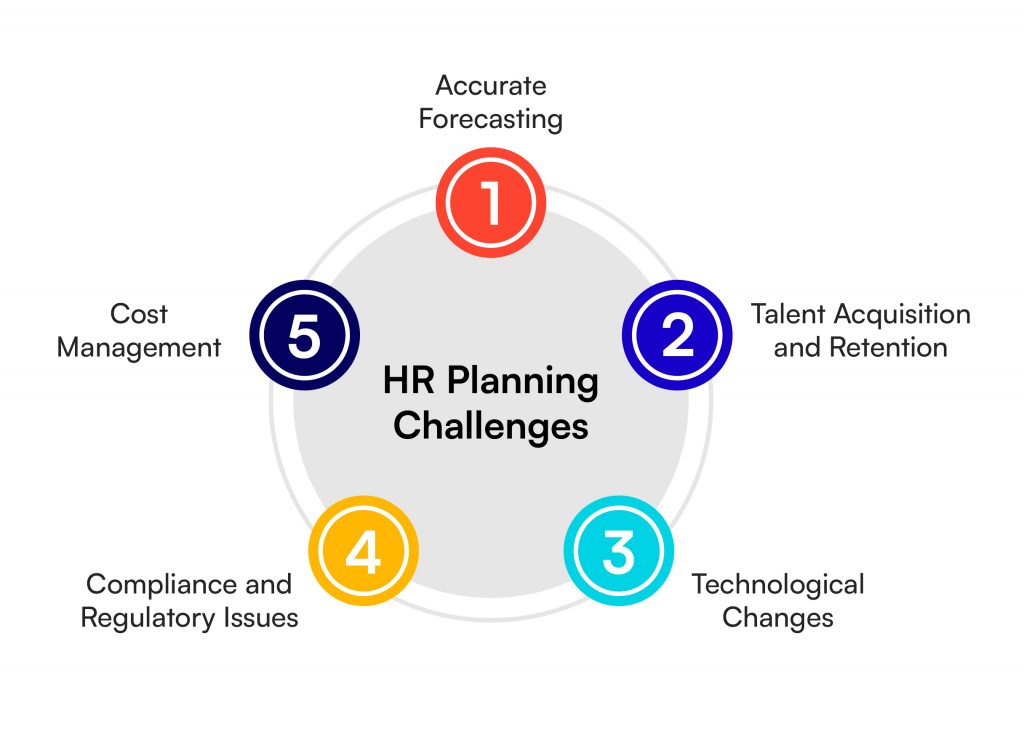
While Human Resource Planning (HRP) is essential for organizational success, it comes with its own set of challenges. Here are some common challenges of HR planning process and strategies to address them:
Challenge 1: Accurate Forecasting
Forecasting future workforce needs accurately can be difficult due to the unpredictability of market trends, economic conditions, and technological advancements. Organizations often struggle to predict the exact number and type of employees they will need in the future.
✅ Solution: Utilize advanced predictive analytics tools and historical data to improve forecasting accuracy. Regularly update forecasts to reflect changing conditions. Involving multiple stakeholders in the forecasting process can also provide a more comprehensive view of future needs, ensuring alignment with financial projections and long-term business goals.
Challenge 2: Talent Acquisition and Retention
Attracting and retaining top talent is increasingly challenging in a competitive job market. High turnover rates can disrupt business operations and increase costs.
✅ Solution: Develop a strong employer brand and offer competitive compensation and benefits packages. Investing in employee development and career progression opportunities can enhance retention. According to the Work Institute, effective HRP can lead to a 15% decrease in turnover rates.
Challenge 3: Technological Changes
Rapid advancements in technology can make existing skills obsolete and require new skill sets. Organizations must continuously adapt to new technologies and ensure their workforce is skilled accordingly.
✅ Solution: Implement continuous learning and development programs to upskill and reskill employees. Partnering with educational institutions and offering in-house training can help employees stay updated with the latest technological trends.
Challenge 4: Compliance and Regulatory Issues
Navigating through various labor laws and regulations can be complex, especially for multinational companies operating in different countries. Non-compliance can result in legal issues and financial penalties.
✅ Solution: Stay informed about relevant laws and regulations through regular updates and consultations with legal experts. Implement robust compliance management systems to ensure adherence to all legal requirements.
Challenge 5: Cost Management
Balancing the costs associated with hiring, training, and retaining employees while maintaining profitability can be a significant challenge.
✅ Solution: Optimize workforce costs through strategic planning and efficient resource allocation. Implement HR analytics to track and manage HR costs effectively.
Key Steps Involved in HR Planning Process
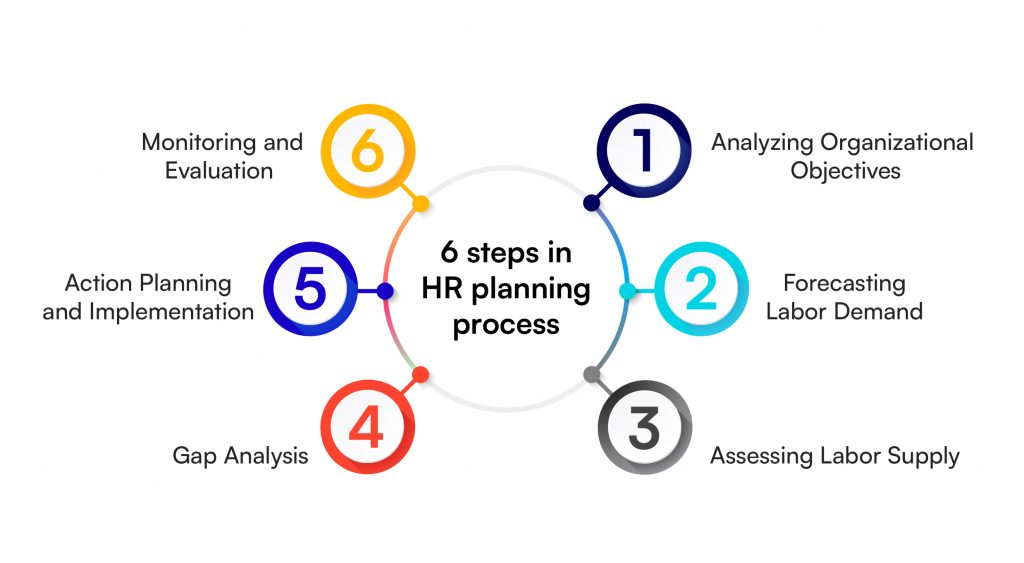
Effective Human Resource Planning (HRP) involves a series of systematic steps to ensure that an organization has the right number of employees, with the right skills, at the right time. Here are the key steps in HR planning.
Step 1: Analyzing Organizational Objectives
Understanding business goals is the first step in HRP. Aligning HR needs with the company’s strategic plans ensures that the workforce supports these objectives. For example, if a tech company plans to launch a new product line in the next two years, HR must identify the types and numbers of engineers, designers, and marketing professionals needed to support this goal.
Step 2: Forecasting Labor Demand
Forecasting labor demand involves predicting future workforce requirements based on business growth, market trends, and technological advancements. This can be done using:
- Qualitative Methods: Techniques like the Delphi method involve gathering expert opinions to estimate future labor needs. For instance, a healthcare organization may use expert panels to forecast the need for specialized medical staff based on emerging health trends.
- Quantitative Methods: Statistical techniques such as trend analysis and ratio analysis use historical data to project future workforce needs. An example is an e-commerce company analyzing past sales data to predict seasonal spikes in demand for customer service representatives.
Step 3: Assessing Labor Supply
Assessing labor supply involves evaluating both internal and external labor markets.
- Internal Supply: This includes analyzing the current workforce’s skills, performance, and potential for future roles. A multinational corporation might use its HRIS to identify employees who can be promoted to leadership positions or transferred to new markets.
- External Supply: This involves studying the labor market to understand the availability of potential candidates. For example, a financial services firm may analyze labor market trends to identify a pool of experienced financial analysts available for recruitment.
Step 4: Gap Analysis
Gap analysis identifies the discrepancies between the current workforce and future labor demand. It involves pinpointing surpluses and shortages in the workforce and developing strategies to bridge these gaps.
For example, a manufacturing company may discover a shortage of skilled machine operators and plan targeted recruitment and training programs to fill this gap.
Step 5: Action Planning and Implementation
Developing actionable plans involves creating specific HR strategies to address the identified gaps. This includes hiring, training, redeployment, and succession planning.
For instance, a retail chain expanding internationally can develop a comprehensive training program for local managers in new markets and establish a succession plan to ensure leadership continuity.
Step 6: Monitoring and Evaluation
Continuous assessment of HR plans is crucial for ensuring their effectiveness. This involves regularly monitoring the implementation of HR strategies and making adjustments based on feedback and outcomes.
Key performance indicators (KPIs) and HR analytics can provide insights into the success of HR plans. For example, a tech startup might use KPIs like employee retention rates and time-to-fill metrics to evaluate the effectiveness of its HRP initiatives.
How Technology Can Help in Strategic Human Resource Planning Process
Technology plays a pivotal role in enhancing the efficiency and effectiveness of Human Resource Planning (HRP). Here are some ways technology can revolutionize HRP:
1. HR Information Systems (HRIS): Streamlining Data Management and Reporting
HRIS platforms provide comprehensive solutions for managing employee data, payroll, benefits, and performance management. These systems enable HR professionals to easily access and analyze employee information, facilitating better decision-making.
For instance, a global corporation can use HRIS to track employee performance across different regions and identify top performers for leadership development programs.
2. Predictive Analytics Tools: Enhancing Forecasting Accuracy
Predictive analytics tools leverage big data and machine learning to forecast future workforce needs more accurately. Tools like IBM Watson Analytics can analyze historical data and predict trends in employee turnover, skill requirements, and recruitment needs.
For example, a tech company might use predictive analytics to forecast the demand for software developers based on upcoming project pipelines and market trends.
3. AI and Machine Learning: Automating Repetitive Tasks and Gaining Deeper Insights
Artificial Intelligence (AI) and machine learning algorithms can automate repetitive HR tasks such as resume screening, interview scheduling, and employee onboarding. Platforms like PeopleStrong use AI to assess candidates’ video interviews, providing insights into their suitability for a role.
Additionally, AI can analyze employee sentiment through natural language processing of survey responses, helping organizations gauge employee engagement and address concerns proactively.
4. Cloud-Based Solutions: Enhancing Accessibility and Collaboration
Cloud-based HR solutions offer flexibility and scalability, allowing HR teams to access information and collaborate from anywhere. These platforms support remote work and provide real-time updates, ensuring that all stakeholders have the latest information.
For example, during a global expansion, a retail chain can use cloud-based HR tools to coordinate hiring and training efforts across multiple countries seamlessly.
5. Employee Engagement Platforms: Improving Communication and Feedback Mechanisms
Employee engagement platforms help organizations measure and improve employee engagement through regular surveys, feedback loops, and sentiment analysis. These platforms enable HR teams to identify issues quickly and implement strategies to enhance employee satisfaction and retention.
For instance, a financial services firm can use an engagement platform to conduct quarterly pulse surveys, gathering insights into employee morale and implementing targeted initiatives to boost engagement.
Conclusion
Human Resource Planning (HRP) is essential for aligning HR strategies with business goals, ensuring organizational flexibility, and supporting long-term objectives. Effective HRP helps organizations have the right talent at the right time, despite challenges like accurate forecasting, talent acquisition, technological changes, compliance, and cost management.
Leveraging technologies such as HR Information Systems, predictive analytics, AI, and cloud-based solutions can streamline HR processes and improve workforce planning accuracy. These tools provide valuable insights and efficiencies, crucial for staying competitive.
HRP is a proactive strategy that prepares organizations for future challenges and opportunities. Companies investing in robust HRP processes and technologies are better positioned to attract, develop, and retain top talent, driving productivity and profitability.
Embrace strategic HR planning and the latest technologies like PeopleStrong to stay competitive. The future success of your business relies on effectively managing its most valuable asset—its people.
Simplify work life and build a future-ready workforce with our comprehensive HR Tech platform. Designed for talent-focused enterprises across APAC, our scalable and agile solutions ensure enterprise-grade security and a mobile-first employee experience. Leverage AI and ML innovations to streamline recruitment, onboarding, core HR, payroll, performance, learning, and more.
Ready to transform your HR processes? Contact us now.

